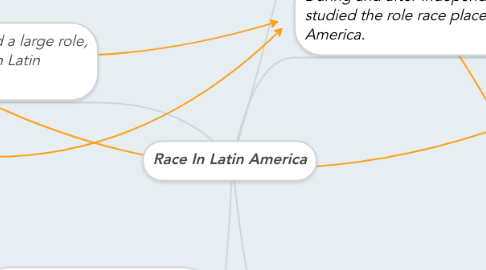Race In Latin America
von Paulina villarreal


1. Many people in Latin America started a search for liberty and equality.
1.1. Haitians had a mission to teach the dangers of slavery and the capability of the black race.
1.2. Movements in Argentina in a search for equality and all voices being heard included indigenismo, socialism, hispanidad, and nationalism.
1.3. With search for liberty after Indepedence partys were made as well: Independent Part of Color.
1.3.1. Little War of 1912, the Rebellion of Afro-Cuban
2. There were various views still in existence of what race held power, and the characteristics certain races possess.
2.1. Though the Haitian Revolution showed the power of blacks, with the cotton gin and South Carolinas new usage of slavery, slavery was still pushed westward.
2.2. In Argentina, the was a division between the rich educated Hispanic American elite and the poor. The power elite held affected education, immigration, and Indian affairs.
2.2.1. Categorizing was still used which degrade Indians.
2.3. There was a view by intellectuals of Indians and Blacks inferiority, but there was a belief Blacks were capable of growth.
3. Though race played a large role, immigration grew in Latin America.
3.1. Immigration increase profoundly there were laws created to limit this: Residence Law of 1902 and the Social Defense Law of 1910.
3.2. The issue of race slowly diminished with the issue of black being pushed aside from new comers of urban positions.
3.2.1. By 1880's Blacks and Indians became small minorities.
3.3. Intellectuals had different opinions in Brazil of immigrations some thought there must be laws to prohibit the migration of blacks and yellows. Others proposed "color blocks."
4. During and after Independence intellectuals studied the role race placed in Latin America.
4.1. Latin American intellectuals were strongly influenced by positivism, social Darwinism, geographical determinism, and many racial theories from Europe.
4.1.1. This led to discussions on the Indian "problem," the black "question," and the consequences of "cross-breeding."
4.2. Argentina had this glorification of whitening, by the 1850's it had fulfilled the elites wishes of being predominantly "European stock." This was possible through massive immigration, wars of extermination against Indians, and the drowning of blacks in the immigrant waves.
4.3. Lots of racial questions due to the fact that no Mexicans were pure Indians or whites (criollos).
4.3.1. Indian status became subjective, race was not appearance only.
4.4. Brazil intellectuals didn't believe solely in biological inferiority. They worried of the misrepresentation of unskilled blacks and believed the "whitening" would improve Brazil.
5. In an attempt for Independence many Revolutions took place.
5.1. Haitian Revolution: the revolt in Saint-Domingue was a large turning point in history it strengthen political arguments outlawing American Slave Trade in 1808.
5.1.1. Help led the French Revolution.
5.2. With the Haitian Revolution there were other countries in search for Independence like Cuba and Mexico.
5.2.1. After Independence Cuba's elites wanted a country like Argentina, being majority European.
5.3. Mexico's Independence began as well with search for political and social progress.
5.3.1. demolishing caste like differentiating.
